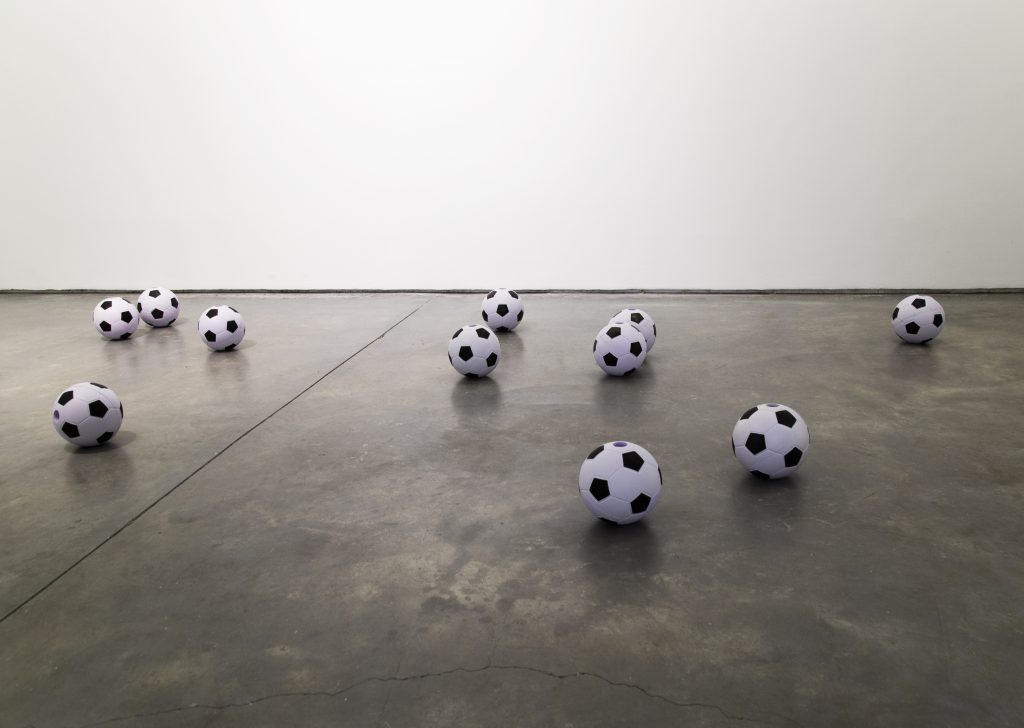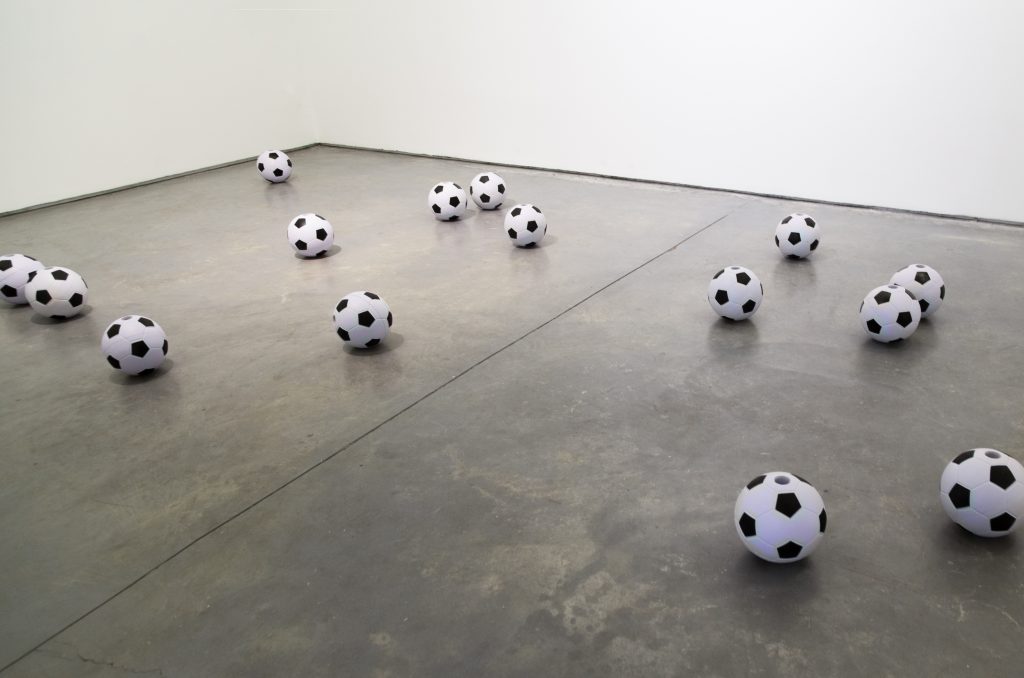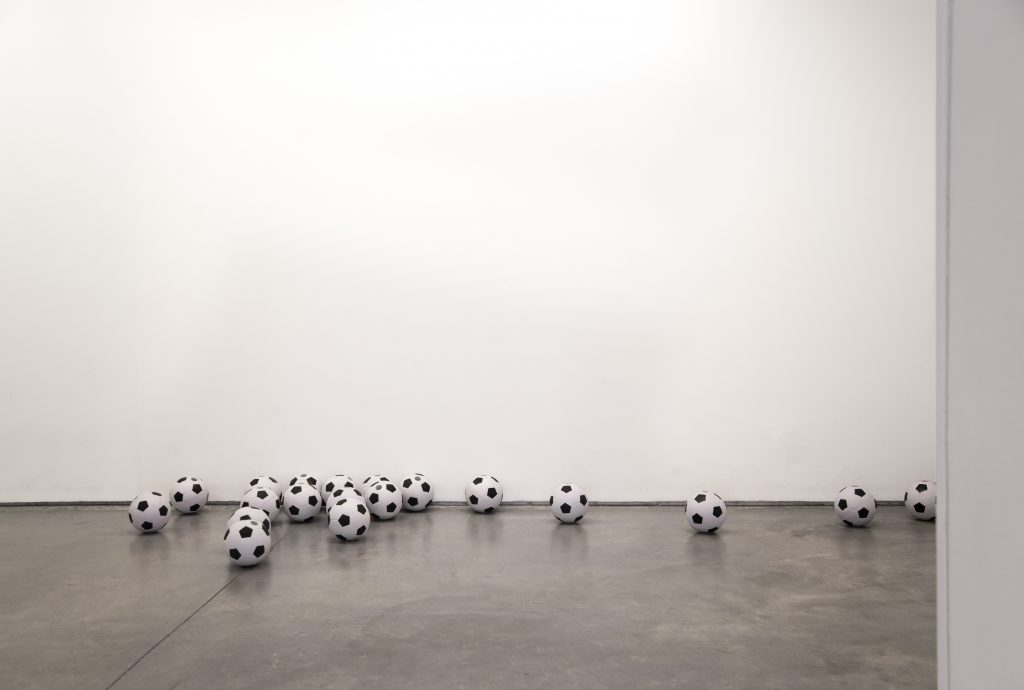Monster Game en Max Estrella
Arturo Moya (2020-23)
Diseño de hardware y firmware: Riley García
Voz: Elena Anaya
Comisario: Gregorio Cámara Castellanos
(english below)
Galería Max Estrella. Abril-Julio 2023
https://maxestrella.com/es/exhibition/el-dia-que-el-universo-cambio/
22 pelotas. Cada una dispone de un altavoz y un dispositivo electrónico capaz de detectar el movimiento. Cuando reciben una patada, el movimiento de la pelota difunde una voz por la sala. La voz cesa cuando la pelota se detiene.
El texto procede de la tesis de 1939 de Mary Tudor An experimental study of the effect of evaluative labeling on speech fluency -Estudio experimental del efecto del etiquetado evaluativo sobre la fluidez del habla-. La investigación trataba de probar que el refuerzo positivo o negativo influía notablemente en el desarrollo de la tartamudez.
Los sujetos del estudio fueron niñas y niños huérfanos de la Casa de Soldados y Marineros Huérfanos en Davenport, Iowa. El estudio partió de dos grupos, uno de hablantes fluentes y otro de infantes que ya eran considerados tartamudos antes del estudio. A cada uno de ellos se les reforzó positiva o negativamente, dando lugar a cuatro subgrupos. Como resultado del estudio algunas niñas y niños fluentes desarrollaron tartamudez de por vida. La tesis fue conocida en los años posteriores a la Segunda Guerra Mundial como “Monster Study” o «Monster Experiment», por su ausencia de consideraciones éticas.
Las locuciones que reproducen las pelotas corresponden a las transcripciones de las entrevistas que la misma autora mantuvo con los 22 sujetos sometidos al estudio. 22 pelotas, una por cada infante.
Monster Game forma parte de “Violencias del decir” un marco de trabajo que se pregunta por las violencias invisibles y formidables del habla.
Fotos: Max Estrella
Arturo Moya (2020-23)
Hardware and Firmware Design: Riley García
Voice: Elena Anaya
Curator: Gregorio Cámara Castellanos
Max Estrella Gallery. April-July 2023
https://maxestrella.com/es/exhibition/el-dia-que-el-universo-cambio/
22 balls. Each one has a speaker and an electronic device capable of detecting movement. When they are kicked, the movement of the ball spreads a voice around the room. The voice stops when the ball stops.
The text comes from Mary Tudor’s 1939 thesis An Experimental Study of the Effect of Evaluative Labeling on Speech Fluency. The research tried to prove that positive or negative reinforcement significantly influenced the development of stuttering.
The subjects of the study were orphaned girls and boys from the Home of Orphan Soldiers and Sailors in Davenport, Iowa. The study started with two groups, one of fluent speakers and another of infants who were already considered stutterers before the study. Each of them was positively or negatively reinforced, giving rise to four subgroups. As a result of the study, some fluent girls and boys developed lifelong stuttering. The thesis was known in the years after World War II as “Monster Study” or “Monster Experiment”, due to its absence of ethical considerations.
The phrases reproduced by the balls correspond to the transcriptions of the interviews that the same author had with the 22 subjects subjected to the study. 22 balls, one for each infant.
Monster Game is part of “Violence of Saying,” a framework that asks about the invisible and formidable violence of speech.












